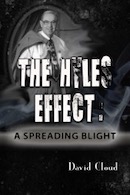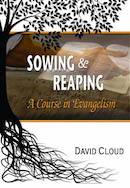866-295-4143, fbns@wayoflife.org
“Darwinism does not look you squarely in the eye” (Michael Pitman, Adam and Evolution, p. 217).
“When our leading scientists have to resort to the sort of distortion that would land a stock promoter in jail, you know they are in trouble” (Phillip Johnson, The Wall Street Journal, 1999).
“Forgeries and frauds are not all that uncommon in the science world” (Paul Chambers, Bones of Contention, p. 248).
“I believe that one day the Darwinian myth will be ranked the greatest deceit in the history of science” (Soren Lovtrup, Darwinism: The Refutation of a Myth).
“The impression that scientists think rationally and fairly is a simplistic myth. The fact is they are subject to the same human failings as the rest of us. Looking inside the ivory towers we find the familiar power establishments, personality conflicts, and intellectual blind spots brought about by philosophical presuppositions” (Ian Taylor, In the Minds of Men, p. 280).
“Within the English-speaking world, Darwin’s theory of evolution remains the only scientific theory to be widely championed by the scientific community and widely disbelieved by everyone else. No matter the effort made by biologists, the thing continues to elicit the same reaction it has always elicited: You’ve got to be kidding, right?” (David Berlinski, The Devil’s Delusion, p. 186).

Lying art.
ARCHAEOPTERYX AND THE DINO-BIRDS
The accepted theory among evolutionists is that birds evolved from reptilian dinosaurs, and the Archaeopteryx has been used as a major icon of this transition for over a century. I have visited every major natural history museum in North America, and all of them feature some type of reconstruction of Archaeopteryx of a missing link.
The Archaeopteryx is actually nothing more than an extinct bird that has been preserved in a handful of fossils. It was the size of a typical “modern bird,” had feathered wings and a long feathered tail. The Darwinists latched onto it as a missing link because of supposed “reptilian” features such as teeth, a long bony tail, and claws on its wings.
It was Thomas Huxley who proposed the dinosaur to bird evolution. In his lectures he had his students envision a “Jurassic past” when “tiny dinosaurs with long hind limbs passed by degrees into ancient flightless birds ... and these via Archaeopteryx’s kin into the song birds heralding today’s dawn” (Adrian Desmond, Huxley, p. 359).
Huxley mocked biblical faith as “blind,” but a dinosaur turning into a bird is pure science fiction.

Though evolutionists generally agree that birds evolved from dinosaurs in some fashion, there are conflicting theories. Some believe that birds evolved from Archaeopteryx or a similar creature. Some believe flying birds evolved from non-flying ostrich-like birds. Others believe that birds did not evolve from dinosaurs but that both evolved from a common ancestor. Some believe that birds evolved from a crocodile-like reptile. One camp holds that birds learned to fly by first learning to glide, while another camp believes that birds evolved powered flight from the ground up.
A typical museum piece is the one at the Australia Museum in Sydney. One display case features Bambiraptor, Archaeopteryx, and a pheasant. The Bambiraptor is running, looking for all the world as if it is trying to get off the ground, while the Archaeopteryx is flying level not far off the ground above the Bambiraptor, perhaps a bit unsteadily as a newcomer to flight, with the pheasant soaring easily above its evolutionary predecessors.
After over a century of fantastic Darwinian hype in literature and museum displays, which have stated or implied that Archaeopteryx was some sort of missing link between dinosaurs and birds, it is now widely agreed that it is simply a bird. (It continues to be paraded before the public in textbooks and museums as a missing link, though. I have visited all of the major natural history museums in America over the past year or so and every one of them use Archaeopteryx as a major missing link and evidence for evolution.)
Paul Chambers concludes his history of the Archaeopteryx with these words:
“Most now feel that the Archaeopteryx is actually a type of primitive bird rather than a feathered reptile or feathered dinosaur” (Bones of Contention, p. 253).
Mark Morell of the American Museum of Natural History said,
“Paleontologists have tried to turn Archaeopteryx into an earth-bound, feathered dinosaur. But it’s not. It is a bird, a perching bird. And no amount of ‘paleobabble’ is going to change that” (“Archaeopteryx: Early bird catches a can of worms,” Science, Feb. 5, 1993, pp. 764-65).
Archaeopteryx had elliptically-shaped wings made of complex flying feathers with the avian barb-barbule system that ingeniously fastens the feathers together to allow for flight.
Its feathers are asymmetrical in shape, meaning there are more filaments on one side of the central vane than the other, which is essential for flight (Chambers, Bones of Contention, p. 217). Like the curved wing of an airplane, the asymmetrical shape of the bird’s wing provides lift. Only flightless birds have symmetrical feathers.
It had a moveable upper and lower jaw, unlike most reptiles which have only a moveable mandible or lower jaw (White and Comninellis, Darwin’s Demise, p. 81).
It had a sternum, which is attached to the muscles used in flying (Chambers, p. 215).
It had a large wishbone for attachment of muscles responsible for the downstroke of the wings (Jonathan Sarfati, Refuting Evolution, p. 59).
It was once thought that Archaeopteryx had solid bones like a reptile rather than thin and hollow bones like a bird, but it is now known that its bones were both thin and hollow.
A CT scan of the brain case of Archaeopteryx performed in 2004 found that the brain was like that of a modern bird. It was larger than that of the typical small dinosaur and had large regions for vision (taking up nearly one-third of the brain), hearing, and muscle coordination. Also, the inner ear “most closely resembles that of modern birds than the inner ear of reptiles.” “These characteristics taken together suggest that Archaeopteryx had the keen sense of hearing, balance, spatial perception and coordination needed to fly” (L. Witmer, “Inside the Oldest Bird Brain,” Nature, 430(7000): 619-620; P. D. Alonso, et al, “The Avian Nature of the Brain and Inner Ear of Archaeopteryx,” Nature, 430(7000): 666-669).
Apart from evolutionary bias and assumption, there is zero evidence that Archaeopteryx is any sort of “missing link.”
What about the supposed “reptile” features? They no more prove that Archaeopteryx was an evolving dinosaur than a platypus’s duck-like bill proves that is an evolving duck.
Francis Hitching, who is an evolutionist, says, “Every one of its supposed reptilian features can be found in various species of undoubted birds” (The Neck of the Giraffe, p. 21).
Evolutionists have never provided evidence of any scientifically feasible means whereby a reptile could change into a bird.
Darwinists focus on a few supposed “reptilian” characteristics of the Archaeopteryx while ignoring the vast amount of fantastic modification that would be required to turn a reptile into a bird.
Following are just some of these:
A heavy earth-bound body would have to evolve into a light-weight, aerodynamic body. Alan Feduccia of the University of North Carolina at Chapel Hill, an evolutionist who is a world authority on birds, says,
“It’s biophysically impossible to evolve flight from such large bipeds [hind legs] with foreshortened forelimbs and heavy, balancing tails” (quoted by A. Gibbons, “New Feathered fossil Brings Dinosaurs and Birds Closer,” Science, 1996, cited from White and Comninellis, Darwin’s Demise, p. 82).
Solid bones would have to evolve into hollow bones that are light but incredibly strong.
Bellows-like lungs would have to evolve into the avian sac-like lungs.
“Bird respiration involves a unique ‘flow-through ventilation’ into a set of nine interconnecting flexible air sacs sandwiched between muscles and under the skin. The air sacs contain few blood vessels and do not take part in oxygen exchange, but rather function like bellows to move air through the lungs. The air sacs permit a unidirectional flow of air through the lungs resulting in higher oxygen content than is possible with the bidirectional air flow through the lungs of reptiles and mammals. ... The unidirectional flow through bird lungs not only permits more oxygen to diffuse into the blood but also keeps the volume of air in the lungs nearly constant, a requirement for maintaing a level flight path” (The New Answers Book 1, pp. 300, 301).
Dr. Jonathan Sarfati describes the vast difference between the reptilian and the avian breathing system.
“Drastic changes are needed to turn a reptile lung into a bird lung. Reptile lungs work like bellows, the air is drawn in, and the stale air is then breathed out the same way it came in. In the lung, blood extracts the oxygen and releases carbon dioxide on the surfaces of ingrowths called septae (singular septa). But birds have a complicated system of air sacs, even involving the hollow bones. This system keeps air flowing in one direction through special tubes (parabronchi, singular parabronchus) in the lung, and blood moves through the lung’s blood vessels in the opposite direction for efficient oxygen uptake, an excellent engineering design. How would the ‘bellows’-style lungs of reptiles evolve gradually into avian lungs?” (Refuting Evolution, pp. 66, 67).
Michael Denton observes,
“Just how such a different respiratory system could have evolved gradually from the standard vertebrate design is fantastically difficult to envisage, especially bearing in mind that the maintenance of respiratory function is absolutely vital to the life of an organism to the extent that the slightest malfunction leads to death within minutes. Just as the feather cannot function as an organ of flight until the hooks and barbules are coadapted to fit together perfectly, so the avian lung cannot function as an organ of respiration until the parabronchi system which permeates it and the air sac system which guarantees the parabronchi their air supply are both highly developed and able to function together in a perfectly integrated manner” (Evolution: A Theory in Crisis).
Scales would have to evolve into complex flight feathers.
“Scales are folds in skin; feathers are complex structures with a barb, barbules, and hooks. They also originate in a totally different way, from follicles inside the skin in a manner akin to mammalian hair. ... For scales to have evolved into feathers means that a significant amount of genetic information had to arise in the bird’s DNA which was not present in that of its alleged reptile ancestor” (Sarfati, pp. 64, 65).
Lymph fluid would have to evolve into blood.
A three-chambered heart would have to evolve into a four-chambered heart.
An egg with a leathery cover would have to evolve into an egg with a hardened calciferous shell.
A land-bound reptile brain would have to evolve into an avian brain capable of thriving in a completely different environment.
A creature that can only croak would have to evolve the ability to sing pretty songs.
This would require the evolution of the two sets of membranes that are located in the songbird’s syrinx (voice box) so that it can produce independent sounds in two voices at once.
“Birds vocalize with the syrinx, a sound-producing organ located at the junction of the two bronchi at the base of the trachea. These two bronchial sides can actually be stimulated independently, so they can each produce different sounds at the same time, as happens in the clear, flutelike song of the Wood Thrush” (Bird Songs: 250 North American Birds in Song, foreword by Jon Dunn, p. 6).
A creature that lives and dies in one place would have to evolve the ability to migrate long distances by air.
The Arctic Tern, for example, migrates more than 9,000 miles from the Arctic to the Antarctic, while the bar-tailed godwit flies from Alaska to New Zealand non-stop, a distance of about 7,000 miles. The golden plover migrates from Alaska to Hawaii, unerringly finding a tiny island in the middle of the Pacific Ocean after a journey of 3,000 miles. The bar-headed goose migrates over the Himalayan mountains, flying more than five and a half miles high where there is little oxygen.
And this amazing reptile to bird process would have to produce 24 orders of birds from eagles to woodpeckers to swans to penguins to hummingbirds!
Career biology instructor Kenneth Poppe observes:
“Try to imagine the incredible numbers of oddball species necessary to bridge the gaps between any lizard and any bird. It takes a most active imagination to conjure even a hypothetical fossil record. For example, describe the anatomy of an intermediate species that transitions from cold- to warm-blooded, which a reptile would have to do en route to becoming a bird. Considering the specificities and complexities of both metabolic systems, any type of ‘half and half’ would be something out of poorly done science fiction” (Reclaiming Science from Darwinism, p. 218).
- Receive these reports by email
- www.wayoflife.org
______________________
Sharing Policy: Much of our material is available for free, such as the hundreds of articles at the Way of Life web site. Other items we sell to help fund our expensive literature and foreign church planting ministries. Way of Life's content falls into two categories: sharable and non-sharable. Things that we encourage you to share include the audio sermons, O Timothy magazine, FBIS articles, and the free eVideos and free eBooks. You are welcome to make copies of these at your own expense and share them with friends and family. You may also post parts of reports and/or entire reports to websites, blogs, etc as long as you give proper credit (citation). A link to the original report is very much appreciated as the reports are frequently updated and/or expanded. Things we do not want copied and distributed are "Store" items like the Fundamental Baptist Digital Library, print editions of our books, electronic editions of the books that we sell, the videos that we sell, etc. The items have taken years to produce at enormous expense in time and money, and we use the income from sales to help fund the ministry. We trust that your Christian honesty will preserve the integrity of this policy. "For the scripture saith, Thou shalt not muzzle the ox that treadeth out the corn. And, The labourer is worthy of his reward" (1 Timothy 5:18). Questions? support@wayoflife.org
Goal:Distributed by Way of Life Literature Inc., the Fundamental Baptist Information Service is an e-mail posting for Bible-believing Christians. Established in 1974, Way of Life Literature is a fundamental Baptist preaching and publishing ministry based in Bethel Baptist Church, London, Ontario, of which Wilbert Unger is the founding Pastor. Brother Cloud lives in South Asia where he has been a church planting missionary since 1979. Our primary goal with the FBIS is to provide material to assist preachers in the edification and protection of the churches.
Offering: Offerings are welcome if you care to make one. If you have been helped and/or blessed by our material offerings can be mailed or made online with with Visa, Mastercard, Discover, or Paypal. For information see: www.wayoflife.org/about/makeanoffering.html.





